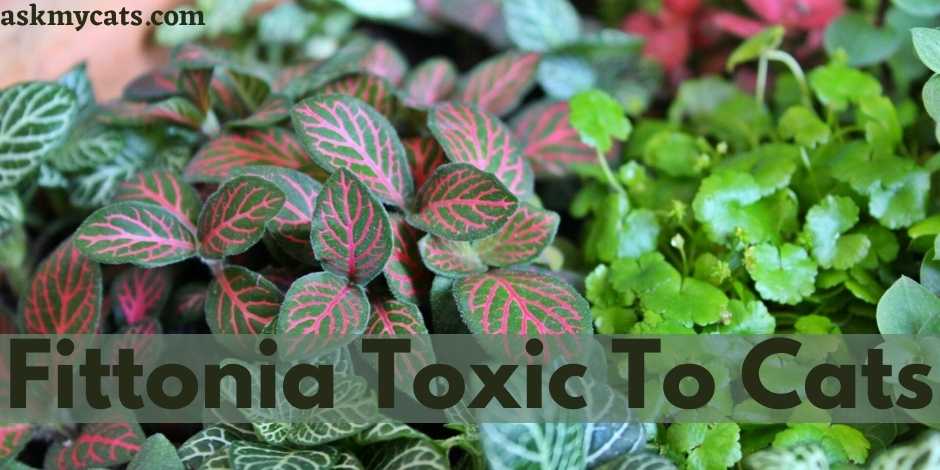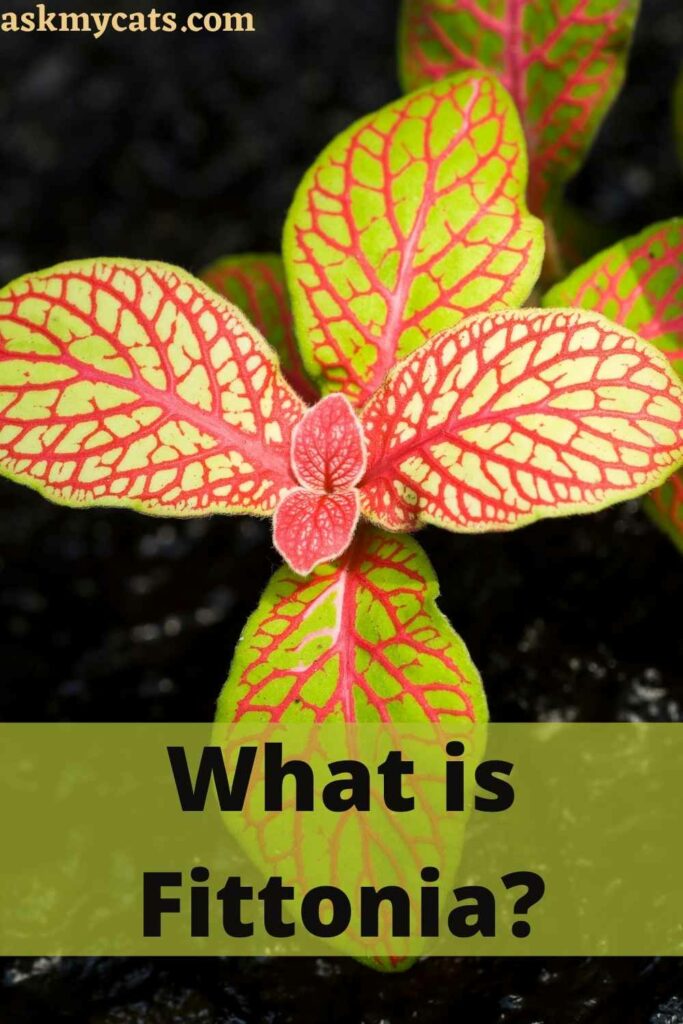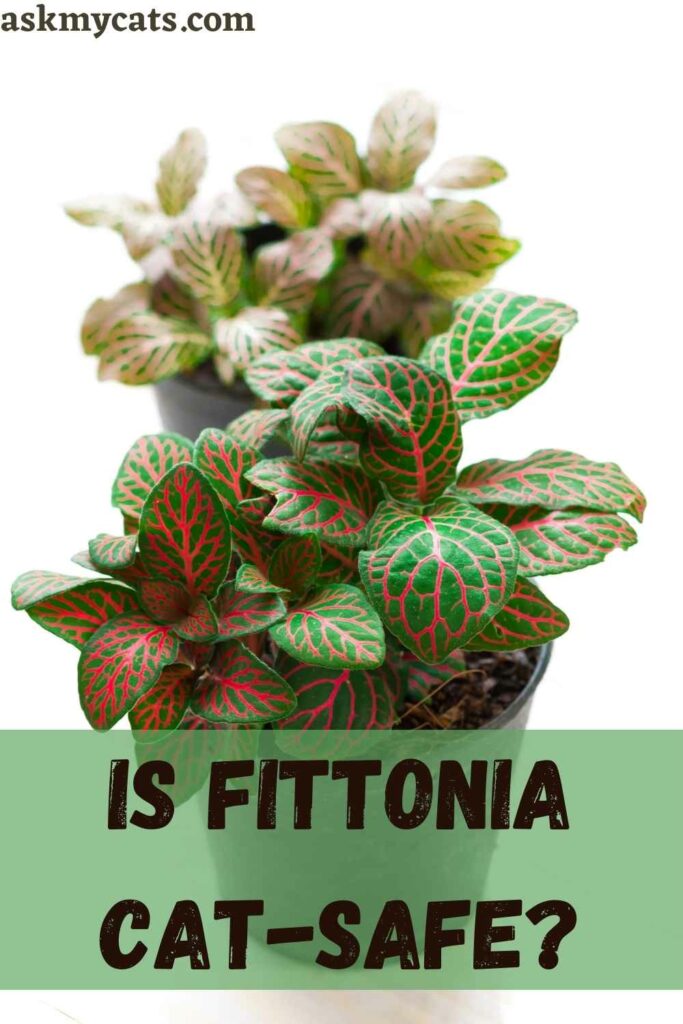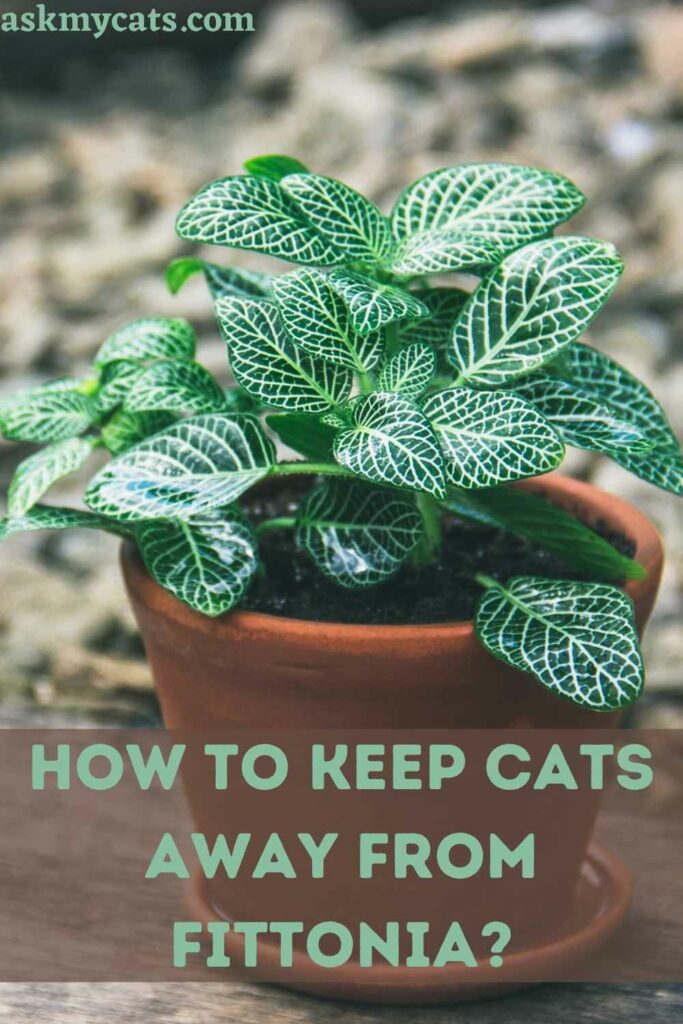Indoor plants have been proved to improve moods, increase creativity, reduce stress, and remove air pollutants, making for a healthier, happier you. Indoor plants can help us feel good as well as look attractive. Indoor plants have been proved in studies to improve your mood, productivity, concentration, and creativity, as well as lessen stress, weariness, sore throats, and colds.
However, is fittonia toxic to cats?
No, fittonia is not toxic to cats. Fittonia is a non-toxic plant that is suitable for cats. Fittonia verschaffeltii is a nickname for Fittonia albivenis, which is the most common species utilized in cultivar production.
This article will talk about the relationship between cats and fittonia plant.


Give Your Cat the Perfect Day
Get the Free Ebook!
What is Fittonia?
The nerve plant, or Fittonia argyroneura, from the Acanthaceae (Acanthus) family, is a tropically found plant with striking leaves of pink and green, white and green, or green and red.

The Fittonia nerve plant, named for its 19th-century discoverers, botanists Elizabeth and Sarah May Fitton, does blossom.
The blooms are inconsequential crimson to white spikes that tend to blend in with the foliage.
When grown as a houseplant, the blossoms of the nerve plant are rarely visible.
This vibrant houseplant, native to Peru and other parts of the South American rain forest, prefers high humidity but not too much water.
In the correct conditions, this little gem can be used in terrariums, hanging baskets, dish gardens, or even as a ground cover.
Low-growing and trailing with oval-shaped leaves on rooted, mat-forming stems, the foliage is low-growing and trailing.
These rooted stem portions can be divided or tip cuttings were taken to make fresh Fittonia nerve houseplants to propagate the plant.
Because the nerve plant is native to the tropics, it thrives in a high-humidity environment. To maintain humid-like conditions, misting may be required.
Fittonia nerve plant prefers moist, well-drained soil that isn’t too wet. Water your growing nerve plants sparingly and allow them to dry out between waterings.
To avoid shock, irrigate the plant with room temperature water. The Fittonia nerve plant, which grows 3 to 6 inches (7.5-15 cm) by 12 to 18 inches (30-45.5 cm) or longer, tolerates strong light to shade situations but thrives in bright, indirect light.
Low light exposure causes these plants to turn green, obliterating the brilliant flashes of colour in the veins.
Growing nerve plants should be kept in a warm environment, away from drafts, as well as water that is too cold or hot. Consider rain forest conditions when caring for your Fittonia nerve houseplants.
Is Fittonia Cat-Safe?
Yes, fittonia is cat safe.

Fittonia (fit-TOH-neeuh), often known as the nerve plant or mosaic plant, is a prominent Acanthaceae family member that can help you relax.
There are two recognized species (Fittonia albivenis and Fittonia gigantea), three plants that may be variations of their own species, and various Fittonia cultivars among these Peruvian indigenous.
The colourful veins, which might be pink, red, white, or yellow, give them their name (and claim to fame).
However, because houseplants are typically hazardous, and the Fittonia’s leaves resemble deadly plants like ivy, these plants may be a little frightening for cat lovers.
Fittonia is a unique example of a common non-toxic plant that is safe with cats, so don’t worry.
It’s worth noting that you can come across material online about a strange species known as “Fittonia verschaffeltii,” which is only a nickname for Fittonia albivenis, the most often utilized species for cultivar development.
The leaves of this plant are not harmful, and people use them to treat headaches, muscle discomfort, and even minor hallucinations.
While it’s unlikely that your cat will notice any of these benefits, it won’t hurt them if they nibble on a few leaves. Fittonias are non-toxic to pets.
Cats, on the other hand, are carnivores, and their digestive processes aren’t built to handle big amounts of plant matter.
As a result, you may experience a few small symptoms that are easily misinterpreted as poisoning.
Fittonia, often known as the nerve plant, is a blooming plant that is not harmful to cats and does not cause any harm to them.
Cats, on the other hand, should not be permitted to eat these plants since they may vomit or have diarrhoea if consumed in large quantities.
Fittonia, often known as the mosaic plant or painted net leaf, is a type of Fittonia nerve plant. Because these distinctive tropical plants are frequently maintained indoors as houseplants, they offer little evident hazard to humans or animals.
The leaves of Fittonia, on the other hand, contain calcium oxalate crystals, which can be hazardous if consumed.
Ingesting the plant leaves will irritate the mucous membranes, whereas any contact with the leaf secretions or juice may cause skin irritation and unpleasant rashes in people.
Although the plant’s effects on cats are less severe than those on people, this does not mean you should let your cats consume the plant leaves.
When a large amount of food is consumed, your cat’s stomach will become upset, resulting in vomiting or diarrhoea.
Although the plant’s effects on humans can be severe, they are moderate on cats and will only manifest if significant volumes of the leaves are consumed. A plant can be only considered toxic if ingesting that plant results in death or some other serious disease.
Fortunately, the Fittonia plant is safe and does not exhibit toxicity to cats.
What Part of Fittonia Is Toxic To Cats?
No part of fittonia is toxic to cats.
The leaves of this plant are not harmful, and people use them to treat headaches, muscle discomfort, and even minor hallucinations.
While it’s unlikely that your cat will notice any of these benefits, it won’t hurt them if they nibble on a few leaves. Fittonias are non-toxic to pets.
Cats, on the other hand, are carnivores, and their digestive processes aren’t built to handle big amounts of plant matter.
As a result, you may experience a few small symptoms that are easily misinterpreted as poisoning.
What Are The Symptoms Of Fittonia Poisoning In Cats?
Fittonia is not poisonous to cats but if your cat ingested a big chunk of the plant, there can be symptoms like diarrhoea and vomiting.
If your cat consumes too much plant stuff, they may experience symptoms comparable to poisoning, but this is due to the nature of their digestive system, not to true harmful effects.
Vomiting, followed by diarrhoea, is likely the most prevalent of these potential symptoms.
There’s also the infamous fact that Fittonia albivenis was once utilized for hallucinogenic reasons, despite the fact that no scientific study on the plant’s chemistry has ever been conducted to determine what substances exist or what effects they have.
However, if your cat eats some and starts hallucinating, you won’t be able to tell the difference.
How To Keep Cats Away From Fittonia?
You can keep cats away from fittonia by following these steps: –

1. Place Fittonia Out Of Their Reach
If your cats are tenacious enough to find and consume Fittonia plants no matter where they are placed.
That means the locations you choose are accessible to the cat, and the plants must be placed in an out-of-reach or difficult-to-reach spot.
The sites you pick should not be near the ground or anywhere near the area where your cats spend most of their time.
Plants should ideally be hung from the ceiling at a height that you can reach.
To keep your fittonia plants above ground, you can install side-mounted shelves in the corners of the room.
2. Spray Liquids That Cats Do Not Like
Making cats detest your fittonia plant is one of the most creative and low-effort strategies to discourage them from eating it.
Many people recommend placing impediments in the way to deter cats from approaching, however, this does not work with persistent cats.
Instead, spray your soil with citrus juices like lemon juice mixed with cayenne pepper powder to make it stinks for your cats. Because cats have such a keen sense of smell, they will avoid anything that smells unpleasant.
Fortunately, people are unable to detect the stench, and cats are the only ones who are affected. Cat repellant can be purchased from local plant stores and used to coat your plants for a similar effect.
3. Give Them Their Own Plant
Using a decoy plant to deal with cats’ plant-eating problems could be a cat-friendly solution. Take note of which plants your cats prefer over fittonia, or give them a fittonia and see whether they still go after the other fittonia plants.
Out of curiosity or to help with an upset stomach, cats will chew on grasses or other plant matter.
If they develop a taste for a plant, though, it can make for some terrible evenings for you, your cat, and the plant that has suddenly become dinner.
You should temporarily remove the plant from reach and visit a veterinarian about this behaviour, as it could be a sign of an unrelated ailment.
If your cat is in good health but still likes to eat nerve plant salad, you might try wiping down the leaves with something unpleasant to see if it deters your cat.
You might also offer it a more permanent residence away from the cat’s grasp.
After a trimming session, dispose of any cuttings you don’t plan to propagate to keep your cat from remembering they enjoy eating this plant.
Frequently Asked Questions
Why is Fittonia called the Nerve plant?
Fittonia is a rainforest plant that thrives in temperatures ranging from 61 to 84 degrees Fahrenheit. It can be kept indoors, however dry surroundings cause the leaves to droop. Fittonia leaves are black in hue, but their veins are quite bright, creating colour contrast. The leaves’ strong contrasting hue resembles the human nervous system, after which the plant is named.
How to take care of Fittonia?
Your Fittonia is a small plant with patterned foliage that is eye-catching. Fittonia is a relatively low-maintenance plant that can endure a variety of lighting conditions and prefer to be kept moist. They thrive in humid surroundings and will benefit from misting on a regular basis. Bright, indirect light is preferred by your Fittonia. It may lose part of its bright colour as a result of the lower light, and its development will be slowed. A lot of light might cause the leaves to burn. Your Fittonia craves water and a damp, but not soggy, environment. When the top half of the soil is dry, water thoroughly. If you allow your Fittonia to become too dry, it will show you with limp leaves. Don’t be concerned! The leaves should perk up quickly after a good watering. Your Fittonia will thrive in temperatures ranging from 65 to 80 degrees Fahrenheit. In the winter, stay away from cold drafts and direct airflow from heaters. Higher humidity levels will benefit your Fittonia. You may increase humidity by misting frequently, using a humidifier, or utilizing a pebble tray. Another technique to boost relative humidity is to create a micro-climate by grouping numerous humidity-loving plants together in a small area. In the spring and summer, feed once a month using a basic houseplant fertilizer diluted to half strength. During the fall and winter months, when growth naturally slows, no fertilizer is required. Fittonia is non-toxic and suitable for pets.
What are other household plants that are toxic to cats?
Around 500 plant species belong to the Dieffenbachia and Philodendron genera, many of which have been cultivated as houseplants. The ever-popular Monstera Deliciosa is one among them. They are, unfortunately, a menace to both humans and cats. In their sap, they produce calcium oxalates, which are poisonous. As a result, raphides, which are little, spiky structures, are created. Dumb Cane and Mother-in-Tongue may exhibit the effects of this drug. Law’s Minor abrasions, inflammation, and swelling of the tongue and the area around the esophagus will occur if the substance is eaten. This could cause breathing problems and, in the worst-case scenario, a respiratory emergency.
Final Words
Fittonia is a tropical blooming plant that is not harmful to cats and does not cause harm to them. However, if cats consume large amounts of these plants, they may experience unpleasant effects such as vomiting or diarrhoea.
If you have any questions, ask us in the comments section.
